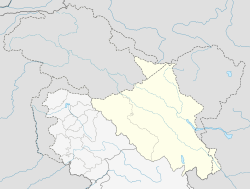Geography
The Fukche Landing Ground is in the Koyul Lungpa river valley, close to the confluence of the river with the Indus River (called "Sengge Zangbo" locally). The Line of Actual Control (LAC) with China, which runs along the Indus River, is only 2.5 kilometres away. [3] Beyond the LAC is Chinese-controlled Demchok sector up to the Chang La pass (also called Xingong La).
Skakjung pastureland, which runs along the right bank of Indus river from China-administered Dumchele and Tsoskar Lake in south to India-administered Dungti-Loma in north, lies on the right bank of Indus river and north of Koyul.
History
The landing ground was first prepared in 1961 in advance of the 1962 Sino-Indian war. It was the sixth such landing ground to be prepared in Ladakh, starting with Leh in 1948 (which was in the midst of the First Kashmir War). According to a retired Army officer, "The Landing Grounds were built on grounds that were hard, barren and sandwiched between almost a range of parallel running mountains. At most places it was a question of removing boulders, filling potholes and generally leveling the ground. The good old infantry equipment of a pick axe, shovel and crow bar came in very handy." [4]
After the 1962 Sino-Indian war, the airstrip fell out of use. It was reopened on 4 November 2008 by the Indian Air Force, when an AN-32 transport aircraft was successfully landed there. [5] [6] The reactivation of the landing ground, along with another reactivation of the Daulat Beg Oldi airstrip earlier in May of the same year, allows Indian forces to deploy faster and in greater numbers, which China is believed to have taken as a threat. [7] During the 2013 Depsang standoff, China demanded the bunkers being constructed at Fukche be stopped. But the Indians pointed out the constant upgrading of the Chinese infrastructure on their side of the LAC. In the end, the Chinese disengaged at Despang without insisting on concessions regarding Fukche. [8]
This page is based on this
Wikipedia article Text is available under the
CC BY-SA 4.0 license; additional terms may apply.
Images, videos and audio are available under their respective licenses.



